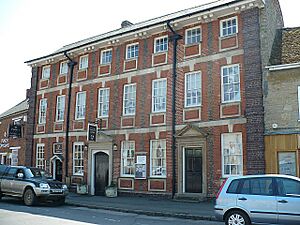Cowper and Newton Museum facts for kids
The Cowper and Newton Museum is a special place in Olney, a town in north Buckinghamshire, England. It's about 8 miles (13 km) northeast of Central Milton Keynes. This museum celebrates the lives and work of two famous people who lived in Olney: William Cowper and John Newton.
William Cowper (1731–1800) was a well-known poet from the 1700s. John Newton (1725–1807) was a church leader who had previously been involved in the slave trade. He later became a strong supporter of ending slavery. Together, Cowper and Newton wrote many songs for church, known as the Olney Hymns. One of these is "Amazing Grace", which is famous worldwide.
The museum is located in a large, red-brick house called Orchard Side. It's a beautiful Georgian style house right on the corner of Market Place in Olney.
Contents
Discovering History at the Museum
The museum building itself is very old, dating back to the Georgian era. It looks much like it did when William Cowper lived there from 1768 to 1786. When you visit, you can see how people lived in the 1700s.
What You Can See
Inside the museum, you'll find many things that belonged to William Cowper. These include his books and personal items. They give you a good idea of what daily life was like during the Georgian period. The museum also has a wonderful collection of lace and items showing the history of Olney. These are displayed in special "Olney Rooms."
Unique Gardens
The museum has two very special gardens. They are unique because they only grow plants that were brought to England before the year 1800. It's like stepping back in time to see the plants people grew centuries ago!
The museum first opened its doors to visitors in 1900.
The Summerhouse Garden
The Summerhouse Garden was once owned by a person who made medicines and lived next door to Orchard Side. After he passed away, William Cowper was allowed to use this garden. It was a place where he grew herbs and medicinal plants.
Cowper's "Verse Manufactory"
Cowper had a unique building in the middle of this garden. He called it his "verse manufactory," which means his poetry-making factory! Only his close friends were allowed to visit him there. After Cowper died in 1800, people who admired his poems came to see this small "literary shrine." Many of them wrote their names and dates on the walls and ceiling. The oldest date found is from 1802, and you can still see all these writings today!
Celebrating "Amazing Grace"
In July 2022, the Cowper and Newton Museum started a special project. It was called "Amazing Grace 250." This project celebrated the 250th anniversary of the famous hymn "Amazing Grace."
Project Funding and Events
The museum received money from several groups, including Milton Keynes City Council, the MK Community Foundation, the National Lottery Heritage Fund, and Arts Council England. This funding helped them create many exhibitions and special events. These celebrations took place in Olney, the wider Milton Keynes area, and other places too.
More About John Newton
Close to the museum is the vicarage, which is the home of a church leader. This is where Cowper's friend, John Newton (1725–1807), wrote the hymn Amazing Grace. John Newton and his wife are buried in the local churchyard.
The museum is supported by the Campaign to Protect Rural England. It is a charity that is mostly run by volunteers who give their time to help.
See also
External links
- Museum website
- Visit Olney information
- BritainExpress information
- Olney Chamber information


